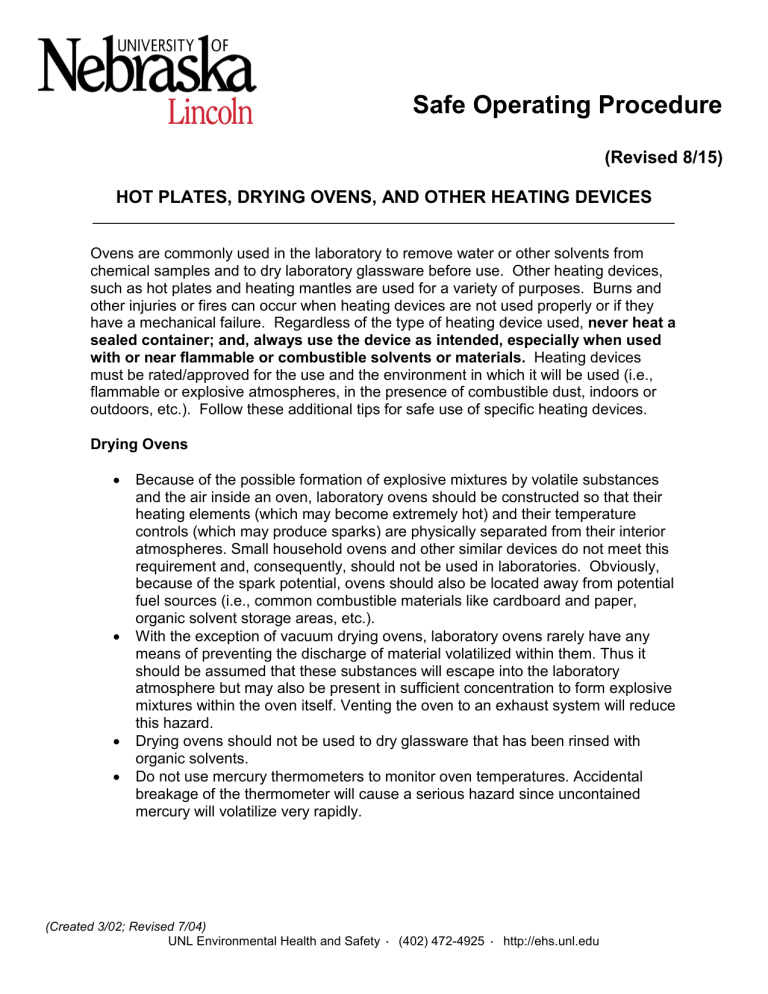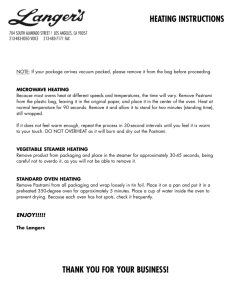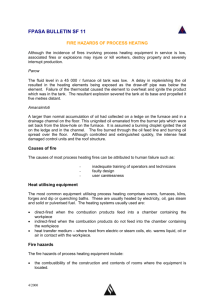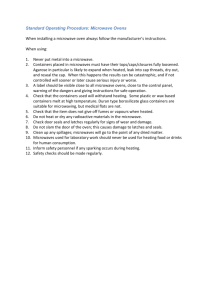Safe Operating Procedure (Revised 8/15)

Safe Operating Procedure
(Revised 8/15)
HOT PLATES, DRYING OVENS, AND OTHER HEATING DEVICES
_____________________________________________________________________
Ovens are commonly used in the laboratory to remove water or other solvents from chemical samples and to dry laboratory glassware before use. Other heating devices, such as hot plates and heating mantles are used for a variety of purposes. Burns and other injuries or fires can occur when heating devices are not used properly or if they have a mechanical failure. Regardless of the type of heating device used, never heat a sealed container; and, always use the device as intended, especially when used with or near flammable or combustible solvents or materials.
Heating devices must be rated/approved for the use and the environment in which it will be used (i.e., flammable or explosive atmospheres, in the presence of combustible dust, indoors or outdoors, etc.). Follow these additional tips for safe use of specific heating devices.
Drying Ovens
•
Because of the possible formation of explosive mixtures by volatile substances and the air inside an oven, laboratory ovens should be constructed so that their heating elements (which may become extremely hot) and their temperature controls (which may produce sparks) are physically separated from their interior atmospheres. Small household ovens and other similar devices do not meet this requirement and, consequently, should not be used in laboratories. Obviously, because of the spark potential, ovens should also be located away from potential fuel sources (i.e., common combustible materials like cardboard and paper, organic solvent storage areas, etc.).
•
With the exception of vacuum drying ovens, laboratory ovens rarely have any means of preventing the discharge of material volatilized within them. Thus it should be assumed that these substances will escape into the laboratory atmosphere but may also be present in sufficient concentration to form explosive mixtures within the oven itself. Venting the oven to an exhaust system will reduce this hazard.
•
Drying ovens should not be used to dry glassware that has been rinsed with organic solvents.
•
Do not use mercury thermometers to monitor oven temperatures. Accidental breakage of the thermometer will cause a serious hazard since uncontained mercury will volatilize very rapidly.
(Created 3/02; Revised 7/04)
UNL Environmental Health and Safety · (402) 472-4925 · http://ehs.unl.edu
•
One must be particularly cautious when drying plastic in an oven due to the risk of fire. Many plastics have melting points well within the temperature range of a typical drying oven.
Material Melting Point
HDPE (High Density Polyethylene) 130° C (266° F)
LDPE (Low Density Polyethylene)
Polycarbonate
PTFE (Polytetrafluoroethylene)
Polypropylene
120° C (248° F)
149° C (300° F)
330° C (626° F)
130° C (266° F)
PVC (Polyvinyl Chloride) 80° C (176° F)
Acetals 160° C (320° F)
If plastic should melt, it can flow onto the heating element and cause a fire. Past oven fires at UNL and nationwide have been attributed to improper temperature settings. When drying plastic, the following guidance should be followed.
•
Polyvinyl chloride should not be dried in an oven. Other plastic should be dried at the temperature of 100° C or less.
•
Ensure that all users are trained in proper operation, settings, and range for each oven that they operate.
•
Verify correct temperature setting before starting the oven, and provide surveillance of the temperature while the oven is in operation.
•
If the oven is not equipped with an actual operating temperature setting and instead uses a scale (e.g., 1 – 10), calibrate and verify the scale settings often.
Heating Devices
The actual heating element of any heating device should be enclosed in a glass, ceramic, or metal case. Heating devices (such as heating mantles) require autotransformers to control the temperature.
•
Auto-transformers must be wired according to code and have a two-pole switch, a three-prong plug, and a power overload device. These devices are to be located away from areas where flammable vapors are produced.
•
Unattended heating devices must be protected with overload circuitry and with a temperature-sensing device that will turn the power off in the event of overheating.
(Created 3/02; Revised 7/04)
UNL Environmental Health and Safety · (402) 472-4925 · http://ehs.unl.edu
•
When cooling water is used in connection with heating (as in the condenser of a solvent still), an automatic device to turn off the power when water flow is interrupted is absolutely necessary.
Heating Mantles
•
When used with auto-transformers, make certain that the auto transformer is properly wired and located.
•
The temperature of heating mantles can be effectively controlled with solid state controllers with a feedback sensor sensing the temperature of the heated liquid.
•
If a solid state controller is used, make sure that the feedback device is fail-safe
(i.e., if the circuit opens the power is turned off).
•
Always support the heating mantle with a ring to allow air circulation around it to prevent overheating of the exterior of the mantel.
•
Never support a heating mantle with combustible materials.
Hot Plates/Heated Stir Plates
•
Hot plates with heating elements that are not totally enclosed must be discarded.
•
Hot plates with temperature control devices must be spark-free.
•
If water or other liquid has been spilled onto the element, have the equipment serviced before use.
•
Allow plenty of time for the hot plate to cool before handling.
Personal Protective Equipment
•
Use thermal gloves or tongs to remove items from their heating units.
•
Use protective eyewear when using ovens, hot plates, or other heating devices.
References: Information contained in this SOP was gathered from the following sources: University of California-Berkeley,
University of Bristol UK, and Clemson University.
(Created 3/02; Revised 7/04)
UNL Environmental Health and Safety · (402) 472-4925 · http://ehs.unl.edu






